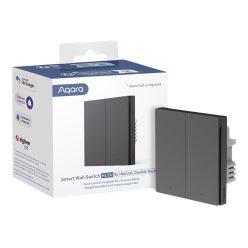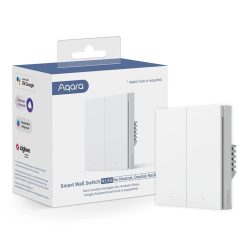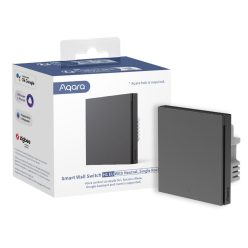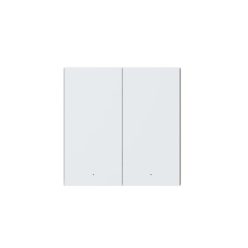
Aqara Smart Switches working with Live + Neutral wiring, or just Live wiring
As more homes turn to smart technology, lighting automation has become a central focus. Aqara's smart switches offer a simple yet efficient way to enhance your home’s lighting system. However, before upgrading, it's crucial to understand the wiring requirements - Live + Neutral wiring versus Live-only wiring - and how they impact the performance and functionality of your smart switch.
Understanding Live + Neutral Wiring vs. Live-Only Wiring
With the spread of smart homes, more and more customers are choosing to smarten and automate their home or office lighting. The most professional solution available for smartening lighting is to install a smart light switch in place of a traditional one. Although the replacement is a simple process, but in older buildings with outdated wiring it could be an unpleasant surprise if only the live wire and the wire going to the light are found in the wall socket only without having the neutral wire being there.
Most smart light switches, whether they use Wi-Fi, Zigbee, or Z-Wave communication, require both the live wire and the neutral wire to be able to function. This is because remote control and automation require a constant power supply, which badly need L+N wiring.
However, several brands offer smart switches that only require a live wire to operate. Brands like SmartWise and Aqara H1 also have switches that work without a neutral wire. However, most devices in smart home manufacturers’ offerings still require live+neutral wiring to function.
It is important to know that using smart
light switches without a neutral wire is a compromise, and they do not provide
the same full functionality or operational stability as switches with
live+neutral wiring. Thus, if technically possible, it is recommended to
install the missing neutral wire in the wall socket and use a live+neutral
switch.
If this is not possible or the customer does not want it, then a smart switch without a neutral wire can also be used. However, these differ not only in their operational mode but also in their functions compared to live+neutral switches, so it is important to understand the differences in order to always choose the right solution for the given situation.
How they are operating?
Since smart switches with only live wiring also need a constant power supply to operate the built-in electronics and wireless communication, they must find a way to provide power without connecting to the neutral wire. This typically happens by allowing a small amount of current to pass through the lighting fixture, even when the switch is in the "off" state. This current is enough to keep the switch’s electronics and wireless module working, but not enough to turn on the light. In some cases, it is justified to install a bypass module at the lamp, which contributes to more stable operation and prevents flickering or vibrating light during use.
It’s important to note that smart switches with only live wiring do not work reliably with all types of light bulbs. Especially low-power LED bulbs and some energy-saving compact fluorescent lamps can cause problems because they don’t work like filaments, allowing less current to pass through – sometimes behaving like a broken circuit – which can affect the smart switch's stable operation.
With smart switches that have only live wiring, the lights may occasionally flicker when off because the switch must draw a small amount of current for operation, which flows through the lighting fixture. This is usually not significant, but in certain situations and with certain lamp types, it can be bothersome.
If stability issues arise with switches that only use live wiring, it is often recommended to install a bypass module in parallel with the lamp, between the switched live wire and the neutral wire, to help stabilize the switch's operation and avoid flickering. This can be installed at the light fixture situated up in the ceiling, where the necessary wires are available.

Wiring diagram in case of presence of only Live wire
The illustration shows that only two wires are present in the smart switch’s mounting box: the live wire and the switched wire that feeds the consumer (lamp). The bypass unit connected in parallel with the light source – in this case, the light source – is installed at the light source, allowing the current flowing through it to supply the power needed for the smart device, which is returned to the smart switch via the terminal connected to the O output.
In contrast, in a mounting box with live, neutral, and switched wires, live+neutral smart switches can be easily used. In this case, the power supply for the smart device is ensured, and no additional bypass device needs to be installed at the light source.

Wiring diagram in case of presence of L+N wires
Smart switches with only live wiring thus provide an innovative solution where neutral wiring is not available, but their use requires more caution, especially with low-power light fixtures. It’s important to check compatibility and, if necessary, change the light source for uninterrupted operation.
It is important to know that if consumption measurement functions are also required, switches with only live wiring are not suitable, as they cannot measure consumption.
Additionally, in some cases – for example, with some Zigbee smart devices – devices powered only by live wiring cannot participate in signal boosting (act as a part of mesh system capable of extending signal territory), and they act as endpoint elements in the communication structure.
If possible, it is advisable to lead the neutral wire to the light switch’s wall socket, as live+neutral switches provide more reliable, stable operation and fuller functionality.
For full renovations or new builds, it is highly recommended to also build the neutral wire into the mounting box for switch fittings.
Key Takeaways on Aqara Smart Switches
- Live + Neutral Wiring: Offers full functionality, better stability, and compatibility with energy monitoring and Zigbee mesh networks.
- Live-Only Wiring: A practical solution for older homes but may require additional components (like a bypass module) for smooth operation and may not work well with certain light fixtures.
- Installation Flexibility: Aqara smart switches are designed to work in a variety of setups, making them versatile for both new constructions and retrofits.
If possible, installing live + neutral wiring will provide the best user experience and functionality. But if rewiring isn’t an option, live-only switches, particularly from Aqara, still provide excellent automation capabilities with just a bit of extra care.
Conclusion
In conclusion, whether you choose a live-only or live + neutral switch, Aqara offers a range of smart solutions to automate your lighting and improve your home's functionality. Live-only wiring switches are a convenient option for older homes, while live + neutral switches provide more advanced features for modern installations. No matter the setup, smart switches are an essential upgrade for anyone looking to create a connected home.
Start smartening up your home today with Aqara’s innovative range of smart switches. Head over to our webshop at SmarterHomeShop.eu and discover the perfect solution for your needs!











